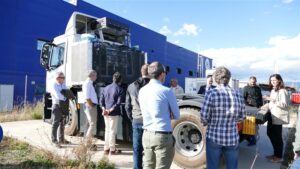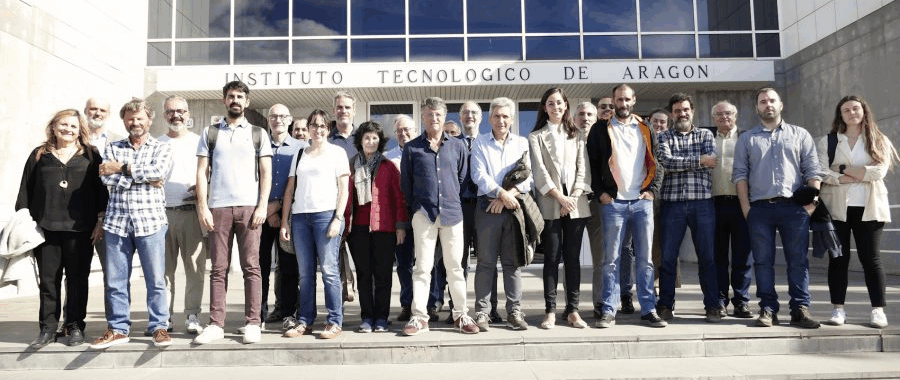The Aragon Technological Institute (ITA), the Aragon Hydrogen Foundation (FHa), and the National Renewable Energy Centre (CENER) in Navarra, have hosted the national reporting session on the achievements made by the different Autonomous Communities (CCAA).
Over October 20th and 21st, the Complementary Plan for Energy and Renewable Hydrogen held its National Meeting at the ITA facilities. This key gathering, which brought together representatives from multiple Autonomous Communities and research centers across Spain, served to share crucial progress in the deployment of green hydrogen technologies essential for the decarbonization of transport and industry.
This strategic program has a total investment of 92 million euros, with a contribution of 71 million from the Ministry of Science, Innovation and Universities through the Recovery and Resilience Mechanism.
Aragon: Leading heavy and light mobility with hydrogen

As part of the planned demonstrations, we showed the live operation of the 700-bar hydrogen refuelling station for light vehicles, an infrastructure funded by the Complementary Plan.
Attendees witnessed the refuelling of a Hyundai Nexo vehicle, while the technical parameters of the process were projected on screen, allowing a detailed understanding of the compressed hydrogen supply system.
Furthermore, the Aragon Technological Institute presented the development of a tractor unit modified to run on hydrogen using a fuel cell, also funded by the Complementary Plan. This prototype was in its commissioning phase during September at the Aragon Hydrogen Foundation facilities, where the first hydrogen refuelling was carried out to validate the correct functioning of all its systems.

This event showcased the tangible results of the collaboration between ITA, the Aragon Hydrogen Foundation, and the University of Zaragoza, the entities leading the Complementary Plan in Aragon. The program, which started in 2022, aims to transform the current energy paradigm by promoting technologies based on green hydrogen, thereby contributing to climate neutrality and sustainable industrial development.
The refuelling station and the tractor unit are concrete
examples of the Plan’s lines of action, which range from green hydrogen generation to its application in heavy transport, as well as high-pressure storage and supply.
The National Green Hydrogen Ecosystem
Basque Country (País Vasco)
The Basque Country has made a strategic contribution to the H2PLAN project, framed within the Complementary Plans of the Ministry of Science and Innovation and aligned with the Elkartek H2BASQUE and ERABILH2 initiatives. Green hydrogen technologies are poised to play a key role in the transition toward a more sustainable energy model.
The work, led by Tecnalia and coordinated by agents of the Basque Science and Technology Network, has comprehensively addressed both hydrogen production—through AEM and PEM electrolysis technologies, as well as advanced thermochemical cycles—and its application in key sectors such as mobility and industry. New materials, catalysts, and membranes have been developed, along with optimized components that improve the efficiency and sustainability of the generation processes.
In terms of using hydrogen as an energy vector, significant progress has been achieved: from the diagnosis and prognosis of fuel cells using 1D-CFD hybrid models, to the design and validation of innovative burners for its combustion. Work has also been done on the intelligent management of hydrogen vehicles and the optimization of on-site generation plants using Machine Learning techniques.
Scientific dissemination and technology transfer have been fundamental pillars of the project, with over twenty scientific publications and active collaboration with the Basque industrial fabric, solidifying the Basque Country as a benchmark in the development of climate-neutral solutions and at the forefront of energy innovation.
Cantabria
Cantabria achieved significant progress in the development and implementation of technologies linked to the production, storage, and application of green hydrogen, within the framework of the Complementary Plan for Energy and Renewable Hydrogen.
One of the main milestones was the installation and commissioning of a green hydrogen generation plant at the University of Cantabria facilities. The hydrogen produced was supplied to several regional companies for use in different production processes, particularly highlighting tests of synthetic rubber hydrogenation, which demonstrated greater efficiency through the use of green hydrogen.
Progress was also made in industrial decarbonization processes, employing captured $\text{CO}_2$ for the synthesis of hydrogen carrier compounds and/or fuels, such as formic acid or formate, obtained through electrochemical $\text{CO}_2$ reduction processes. These compounds showed their utility as a source of renewable energy, with the operation of formic acid in a fuel cell as an alternative and sustainable energy vector having been experimentally demonstrated.
These results consolidated Cantabria’s role as a national reference in promoting renewable hydrogen technologies and the circular economy, integrating research, industrial innovation, and energy sustainability.
Asturias
The research developed in Asturias is focused on the industrial use of hydrogen, comprehensively addressing the entire value chain from a perspective of circular economy, digitalization, and industrial decarbonization.
The project, which integrates the capacities of nine partners —INCAR, University of Oviedo (CRC and GIPIS), Iturcemi, Idesa, MagnaDea, Idonial, H2Vector, and ArcelorMittal— seeks to develop technological solutions that enable the transition toward a hydrogen-based energy model.
It demonstrates how to leverage existing and residual resources to generate high-purity hydrogen. Through PSA systems with activated carbons, steel gases (COG) are enriched from 57% to purities above 90%, while the gasification of residual biomass and waste with supercritical water achieves efficiencies of 50%, integrating streams through steam reforming and optimized catalysts.
This renewable hydrogen production is directly connected to secure infrastructures including high-yield cylindrical tanks, pipes with anti-embrittlement coatings, and LOHC systems for liquid storage, guaranteeing the technical viability of transport and storage.
Experimental blending test benches allow for the progressive incorporation of $\text{H}_2$ into current energy applications, while combustion studies optimize the use of synthesis gas in industrial burners, reducing emissions and intermediate compounds. In the steel sector, it has been verified that atmospheres with 80% hydrogen accelerate pellet metallization without compromising material quality, demonstrating the feasibility of replacing fossil fuels in metallurgical processes.
The development of advanced materials covers all aspects: from PEM electrolysers with stainless steels instead of precious metals to protective paints and refractories resistant to hydrogen atmospheres. These innovations are generalized and validated through complete digitalization culminating in the creation of immersive 3D digital twins that integrate physical simulations, SCADA systems, and artificial intelligence models capable of predicting thermal behavior and emissions, while Life Cycle Analysis (LCA) evaluates the environmental impacts of each solution during the implementation phase itself.
ArcelorMittal leads the industrial implementation with facilities that include gas conduction systems, electrical infrastructures, and an operational PSA pilot plant by 2026, closing the cycle from research to real application in productive environments.
Madrid
The objective is to position the region in R&D&I of green hydrogen and fuel cells, integrating hydrogen generation from renewable energies, its utilization in sectors difficult to electrify (transport and industry), and the development of a new regional value chain.
CIIAE
The Iberian Energy Storage Research Centre (CIIAE) is executing its commissioning under action line 13 of the Complementary Plan for Energy and Green Hydrogen.
Within this line, CIIAE has a total of 96 workers, who carry out their activities in temporary laboratories and offices at the Cáceres campus of the University of Extremadura, conditioned and equipped by this project. This personnel works in three research areas: electrical storage, hydrogen, and thermal storage.
Thanks to this complementary plan, they have been able to participate in numerous scientific events and associations, both national and international, to disseminate their initial results. As of October 20, 2025, activities totaling €11,271,907 have been executed.
Castilla La Mancha
The scientific progress of the complementary plan for energy and renewable hydrogen is presented by the Community of Castilla La-Mancha, highlighting the development status of pilot plants for the generation of synthetic fuels (methanol and Fischer-Tropsch production unit) and pilot plants for the valorization of agroforestry and agro-industrial products (Oxygasification and Anaerobic Digestion). Furthermore, scientific advances related to hydrogen generation using low-temperature electrolysis systems will be presented, covering everything from the synthesis and characterization of materials and components to the design and construction of test benches for the electrochemical characterization of small systems. Regarding activity in high-temperature fuel cell systems and electrolysers, progress in the development of materials, components, and systems for hydrogen generation and transformation in industrial environments will be shown. Finally, actions developed in the field of training, dissemination, internationalization, and coordination of the plan will be updated.
Castilla León
The H2MetAmo project is developed by the Autonomous Community of Castilla y León, with the participation of the 4 public universities (Burgos, León, Salamanca, and Valladolid) and the Technology Centers CARTIF and CIDAUT. The objective of the project is the design of small-scale plants—for distributed production—of ammonia and methane from sustainable hydrogen. The work has focused on the development of supports and catalysts for both processes, the characterization and proposal of new materials that can treat the fed hydrogen or its mixtures without embrittlement, as well as the optimized design of the plants through process simulation, taking into account factors such as raw material availability, energy, and mass transfers inside the proposed reactors. Finally, for the verification of the catalysts, supports, and design proposals, lab-to-pilot scale reactions were performed, yielding interesting results for new catalysts and their manufacturing possibilities, with very good results for methane production, and ongoing work to adapt them to ammonia production.
Specific training through a degree designed in the project, with great participation from other universities, research centers, and companies, has trained 40 hydrogen experts and cohesive the training, research, and business system around hydrogen in Castilla y León.
CSIC
The Spanish National Research Council (CSIC) actively participates in the development of the Complementary Plan for Energy and Renewable Hydrogen, a strategic national initiative aimed at accelerating the energy transition by boosting technologies for the production, storage, and utilization of green hydrogen and advanced biofuels. The CSIC’s participation is articulated through various Integrated Activity Laboratories (LIA), with concrete objectives that combine basic and applied research, technological demonstration, and pre-commercial scaling. This contribution fully aligns with the CSIC’s mission as a driving force of knowledge and technology in critical areas for the decarbonization of the economy and energy sustainability.
The CSIC’s participation in these lines reinforces its role as a key agent in the development of green hydrogen technologies and sustainable fuels. These actions are not only generating frontier knowledge and advanced technological developments but are also contributing to the consolidation of research and demonstration infrastructures with strong potential for transfer to the energy industry and the hydrogen value chain in Spain.
Canary Islands (Canarias)
The Canary Islands address the crucial challenge of decarbonizing the energy system through the use of green hydrogen. The generation plant is located on the PLOCAN offshore Oceanic Platform, making it a pioneering infrastructure, as it generates hydrogen in a marine environment and with the exclusive use of marine renewable energies. The infrastructure designed by PLOCAN is a scaled-down prototype of island systems, combining self-consumption, intelligent energy management using machine learning and artificial intelligence, marine technologies, and energy storage. The generation of renewable hydrogen on this offshore platform will pave the way for the complete decarbonization of isolated or weakly connected electrical systems and the use of hydrogen for the decarbonization of the blue economy.
Extremadura
The Autonomous Community of Extremadura has participated with the construction and commissioning of several pilot plants, framed within the green hydrogen value chain.
In this regard, two green hydrogen generation plants have been built from surplus electrical energy from self-consumption photovoltaic installations, as well as a plant for obtaining hydrogen and biogas from biomass.
The hydrogen generated in these plants is subsequently used in various ways, such as in feeding fuel cells, in small and medium-power domestic and industrial applications, in combustion applications in domestic and industrial boilers (direct or mixed with natural gas), and in the manufacture of biofuels.
Navarra
In the town of Aoiz, they have developed a facility for generating biofuels from hydrogen and $\text{CO}_2$. And in Sangüesa, a high-temperature hydrogen generation facility from renewable energy and by leveraging residual heat. Both pieces of equipment were visited on October 22nd by the representatives of the CCAA that make up this project.
The future is today: The consolidated national hydrogen roadmap
The National Meeting of the Complementary Plan has gone beyond mere accountability. It has served as the consolidation of a shared roadmap where basic research, industrial demonstrations, and mobility prototypes (such as 700-bar refuelling and Aragón’s tractor unit) are already a reality. This ambitious investment program is not only funding frontier technology; it is weaving a national network of knowledge and application that ensures Spain’s position at the European forefront in the transition towards an energy model based on renewable hydrogen.

